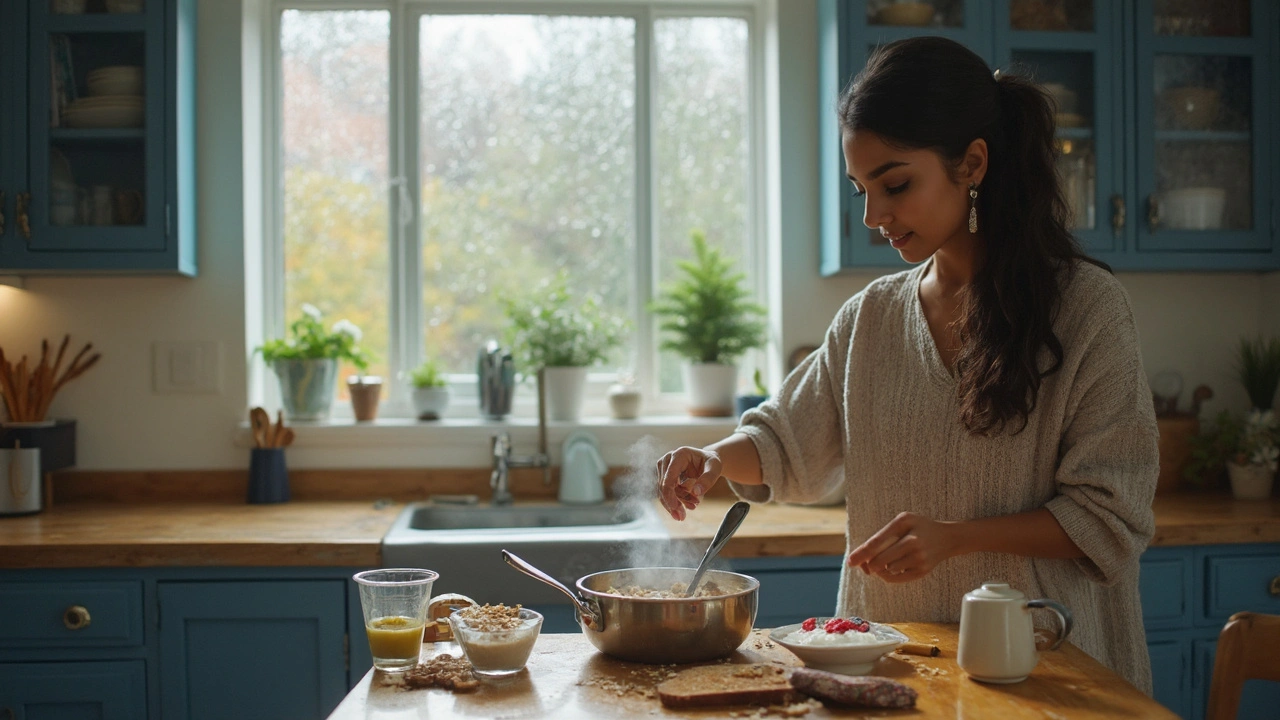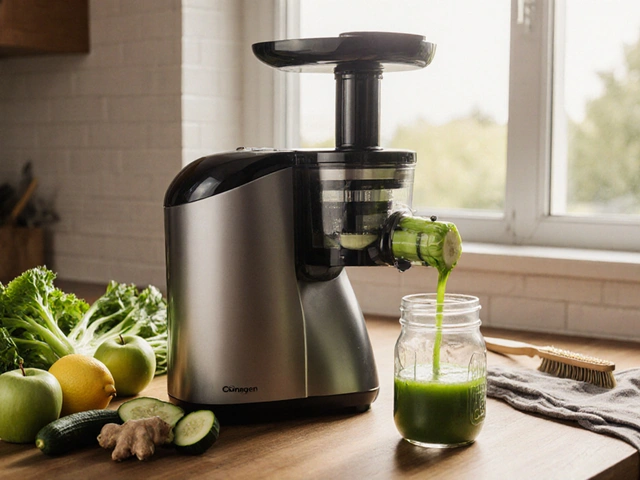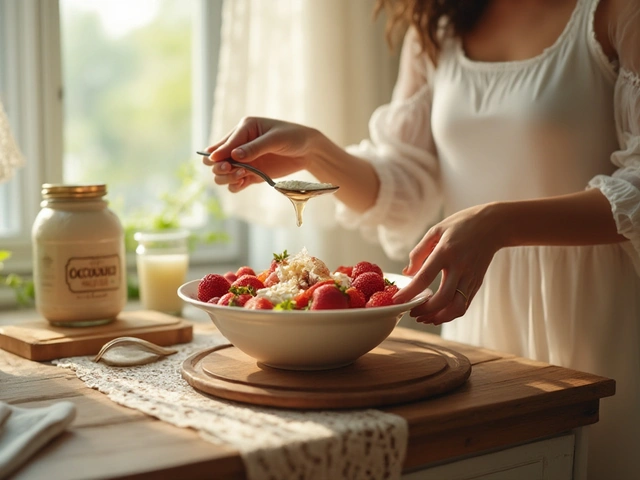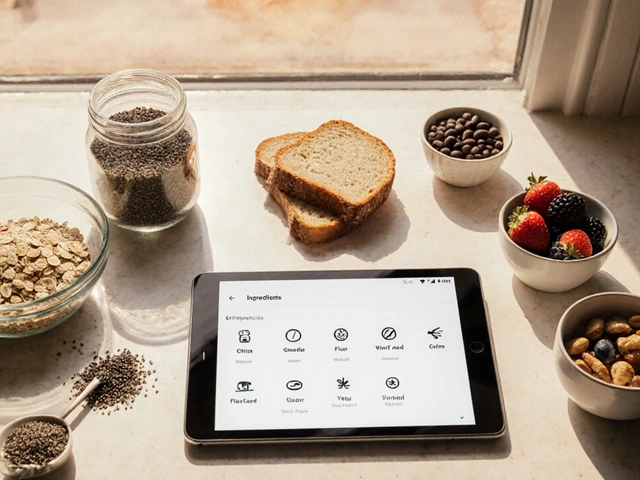You don’t need a supplement stack or a chef’s kitchen to feel better in your belly. Most people can improve gut health with a few steady changes-more fibre, a couple of fermented foods, daily movement, and calmer evenings. Expect small wins in a week (less bloating, more regularity), with bigger shifts over 4-8 weeks. I live in Bristol, cook in a normal-sized flat, and everything here is doable with UK groceries and a busy schedule.
TL;DR: Quick wins you can start today
Short on time? Here are the essentials.
- Aim for 30g fibre a day (NHS adult target). Start low and build up; drink more water as you go.
- Eat 2 servings of fermented foods daily (e.g., live yoghurt, kefir, sauerkraut) and 30 different plants a week (fruits, veg, nuts, seeds, wholegrains, legumes, herbs).
- Move after meals: a 10-20-minute walk helps digestion and blood sugar.
- Sleep 7-9 hours and keep evenings calm; stress and poor sleep disrupt motility and the microbiome.
- If you’re very bloated or have IBS, add fibre slowly and consider a low-FODMAP strategy with a registered dietitian.
Evidence touchpoints: NHS recommends ~30g fibre/day; the American Gut project suggests “30 plants/week” for diversity; a Stanford trial (2021) found fermented foods increased microbiome diversity and reduced inflammatory markers; gentle post-meal walking improves glucose and gastric emptying in small controlled studies.
Step-by-step: A simple 7-day at-home gut reset
No detoxes. No extreme rules. Just a clear routine that fits real life.
-
Morning anchor (10-15 minutes)
- Hydrate: 300-500 ml water on waking. Add a squeeze of lemon if you like the taste.
- Breakfast builder: pick one-(a) overnight oats with chia and berries; (b) eggs on wholegrain toast with tomatoes; (c) live yoghurt or kefir with nuts, seeds, and fruit.
- Move a bit: 5 minutes of gentle stretching or a brisk 10-minute walk if commuting allows.
-
Lunch that travels
- Base: wholegrains (brown rice, quinoa, wholewheat couscous) or beans/lentils.
- Add colours: 2-3 veg (peppers, spinach, carrots, beetroot). Toss in herbs for polyphenols (mint, parsley).
- Fermented topper: a spoon of sauerkraut or kimchi, or a small kefir to drink.
-
Smart snacks (once or twice)
- Fruit + nuts (apple + walnuts), or carrots + hummus, or oatcakes + cheese.
- Tea and coffee are fine; keep caffeine earlier in the day if sleep is wonky.
-
Evening calm
- Half-plate veg at dinner. Add legumes a few nights a week (e.g., lentil bolognese).
- Short walk after dinner (10-20 minutes). It helps motility and glucose control.
- Light down by 10-11 pm; 7-9 hours sleep supports regular bowel rhythms.
Here’s a 7-day example-mix and match to taste.
- Day 1: Overnight oats, a grain bowl with chickpeas and veg, salmon with roast veg + kefir.
- Day 2: Eggs on seeded toast, lentil soup, tofu stir-fry + sauerkraut.
- Day 3: Live yoghurt with berries and nuts, tuna and bean salad, turkey chilli + brown rice.
- Day 4: Smoothie (spinach, banana, flax, kefir), wholegrain wrap with hummus and veg, baked potato + cottage cheese + coleslaw.
- Day 5: Porridge with chia and cinnamon, leftover chilli, pasta with tomato, olive oil, olives, capers, and a side salad.
- Day 6: Mushrooms on toast, sushi or poke with edamame, roast chicken + three veg.
- Day 7: Yoghurt bowl, vegetable frittata + salad, chickpea curry + rice.
Key habits across the week:
- Hit ~30 plants by counting different fruits, veg, grains, legumes, nuts, seeds, herbs/spices. Coriander, cumin, and cocoa all count.
- Two fermented servings daily: live yoghurt, kefir, sauerkraut, kimchi, miso, tempeh, or kombucha (watch the sugar).
- Fibre ladder: add 5g/day each week until you reach 25-30g. If gassy, pause at that level for a few days.
- Water target: 6-8 cups/day (NHS guidance), more as fibre climbs or if you’re active.
Examples and recipes: Easy UK-friendly meals and snacks
These are fast, affordable, and available at most supermarkets.
1) 5-minute overnight oats (serves 1)
- 40 g rolled oats, 1 tbsp chia, 150 g live yoghurt or 200 ml kefir, 80-100 g berries, pinch cinnamon.
- Mix, chill overnight. Add a drizzle of honey if needed. ~8-10 g fibre, fermented ticked if using kefir.
2) Lentil bolognese (serves 4)
- Base: 1 onion, 2 carrots, 2 celery sticks, 2 garlic cloves (or garlic-infused oil for low-FODMAP).
- 400 g tin lentils (drained) + 400 g tin chopped tomatoes + 1 tbsp tomato puree + Italian herbs.
- Sweat veg in olive oil, add tomatoes and lentils, simmer 15-20 mins. Serve on wholewheat pasta. ~12 g fibre/portion.
3) 7-veg tray roast with tahini drizzle
- Pick any 7 small portions: pepper, courgette, onion (or spring onion tops), carrot, beetroot, broccoli, mushrooms, cherry tomatoes.
- Roast at 200°C with olive oil, salt, pepper. Mix 2 tbsp tahini + lemon + warm water to drizzle.
4) 2-minute sauerkraut toast
- Two slices seeded toast, top with avocado, a spoon of sauerkraut, and a fried egg.
- Great after a night shift or post-gym. Fermented + fibre + protein.
5) Yoghurt bowl (live cultures)
- 200 g live yoghurt, 1 tbsp ground flaxseed, a handful of nuts, chopped pear, sprinkle of cocoa nibs.
- Flaxseed supports regularity; cocoa adds polyphenols.
6) Simple chickpea curry (30 minutes)
- Onion (or asafoetida for low-FODMAP), garlic, ginger, curry powder, 1 tin chickpeas, 1 tin tomatoes, handful spinach, coconut milk splash.
- Serve with brown basmati rice. Big fibre hit; easy batch-cook.
7) Walk-and-eat snack kit
- Oatcakes + peanut butter sachet; or a banana + small kefir; or carrots + mini hummus pot.
| Food | Typical UK portion | Approx fibre/portion | Fermented? | Notes |
|---|---|---|---|---|
| Rolled oats | 40 g dry | ~4 g | No | Add chia (1 tbsp = ~5 g fibre) to boost. |
| Chickpeas (tinned, drained) | 120 g | ~7 g | No | Rinse to reduce gas-forming oligosaccharides slightly. |
| Lentils (tinned, drained) | 120 g | ~5-6 g | No | Great mince swap for bolognese or shepherd’s pie. |
| Raspberries | 100 g | ~6.5 g | No | Frozen is fine and cheaper. |
| Ground flaxseed | 1 tbsp (~7 g) | ~2 g | No | Supports regularity; start at 1 tsp if new. |
| Live yoghurt | 150-200 g | ~0 g | Yes | Look for “live cultures” on label. |
| Kefir | 200 ml | ~0 g | Yes | Choose plain to limit added sugar. |
| Sauerkraut/kimchi | 1-2 tbsp | ~1 g | Yes | Unpasteurised for live bacteria; keep refrigerated. |
| Wholegrain bread | 2 slices | ~6 g | No | Check “wholemeal” as first ingredient. |
| Almonds | 30 g | ~3.5 g | No | Good prebiotic effect; mind portions if weight loss goals. |
Note: Fibre values vary by brand/cooking. These are solid ballparks for planning.

Checklists and cheat-sheets: Shopping, portions, daily habits
Make it easy on yourself. Use these prompts each week.
Plant-30 tracker (tick off different plants you’ve eaten):
- Fruits (aim 7+): apple, pear, banana, berries (any), kiwi, orange, grapes.
- Veg (aim 10+): broccoli, spinach, kale, carrots, peppers, tomatoes, beetroot, onions/spring onion tops, mushrooms, courgette.
- Legumes (aim 3-5): chickpeas, lentils, black beans, kidney beans, edamame.
- Wholegrains (aim 4-6): oats, brown rice, quinoa, wholewheat pasta, wholemeal bread.
- Nuts/seeds (aim 5+): almonds, walnuts, pumpkin seeds, chia, flaxseed.
- Herbs/spices (as many as you like): parsley, coriander, cumin, oregano, cinnamon, ginger, turmeric.
Fermented-two-a-day (choose any): live yoghurt, kefir, sauerkraut, kimchi, miso soup, tempeh, kombucha (low sugar).
Portion rules of thumb:
- Half your plate veg at lunch/dinner.
- 1 handful nuts (~30 g) or 1 tbsp seeds a day.
- 1 fist-sized portion of wholegrains or beans per main meal.
- Water: 6-8 cups daily; add 1 extra cup per additional 5 g of new fibre you’re trying.
Fibre ladder (to avoid sudden bloating):
- Week 1: Add 5 g/day (e.g., oats + 1 tsp chia).
- Week 2: Add another 5 g/day (swap white for wholemeal; add a fruit with skin).
- Week 3: Add legumes 3x/week (½ cup servings).
- Week 4: Hit ~30 g/day; maintain.
Low-FODMAP swaps (if you suspect IBS):
- Use garlic-infused oil instead of garlic; spring onion tops instead of bulbs.
- Choose lactose-free yoghurt/kefir; hard cheeses are usually fine.
- Pick low-FODMAP fruits (kiwi, berries, oranges) and grains (oats, rice, quinoa) during the elimination phase; reintroduce strategically with a dietitian.
7 daily gut habits:
- Drink water on waking.
- Eat protein + fibre at breakfast.
- Walk 10 minutes after your largest meal.
- Have two fermented servings.
- Eat the rainbow (3+ colours/day).
- Protect your sleep window.
- Breathe 4-6 slow breaths before meals to shift out of stress mode.
Mini-FAQ and troubleshooting
Do I need a probiotic supplement?
Not always. Food-first works for most. If you’re on antibiotics, a short course of a broad-spectrum probiotic timed away from the dose may reduce antibiotic-associated diarrhoea (Cochrane reviews). For IBS, certain strains (e.g., some Bifidobacterium and Lactobacillus) can help bloating, but responses vary. If you try one, pick a product with strain IDs and give it 4 weeks.
How quickly will I feel better?
Many notice less bloating and better stools in 7-14 days with more fibre, water, and walking. Microbiome diversity shifts are slower-think weeks to months. Keep stacking small habits.
Is coffee bad for my gut?
Not inherently. One to three cups/day is fine for most and may stimulate motility. If you get reflux or anxiety, keep it earlier in the day, have it with food, or switch to half-caf.
Alcohol?
Keep it light. Alcohol can irritate the gut and alter the microbiome. Aim for several alcohol-free days weekly; drink with food; hydrate between drinks.
Gluten-free for gut health?
No need unless you have coeliac disease or non-coeliac gluten sensitivity confirmed. Wholegrains are great for fibre. If symptoms point to coeliac disease (unexplained anaemia, weight loss, chronic diarrhoea), see your GP for testing before changing your diet.
Histamine intolerance and fermented foods?
If fermented foods trigger flushing, headaches, hives, or gut cramps, you may be sensitive to histamine. Stick to live yoghurt/kefir in small amounts or pause fermented foods and work with a clinician.
Constipation tips?
Increase fibre gradually, drink more water, add 1-2 tbsp ground flaxseed daily, and walk after meals. A kiwi a day can help (good evidence for stool frequency). Set a regular bathroom time after breakfast when the colon is most active.
Diarrhoea or urgency?
Focus on soluble-fibre foods (oats, bananas, potatoes, chia), reduce alcohol and caffeine, and watch high-fat takeaways. If persistent or with blood/fever, call your GP or NHS 111.
Gas and bloat after beans?
Start with small portions (2-4 tbsp), rinse canned beans very well, try lentils before chickpeas, and consider pressure-cooked legumes. Your gut usually adapts within 1-2 weeks.
Which tests actually matter?
For most healthy adults, you don’t need stool microbiome kits. They’re interesting but not prescriptive. If you have ongoing symptoms, ask your GP about coeliac testing, iron/B12, thyroid, CRP, and calprotectin to rule out IBD.
Next steps by scenario: fine-tune without the faff
If you’re a busy parent: Batch-cook lentil bolognese and bean chilli; freeze in portions. Keep a snack box with nuts, fruit, oatcakes, and mini hummus. Make overnight oats jars for two days at a time.
If you’re a student or on a tight budget: Tinned tomatoes, beans, and lentils are your best mates. Frozen veg is as nutritious as fresh and cheaper. Buy plain yoghurt in big tubs; add fruit yourself. Aldi/Lidl often stock kefir and sauerkraut now-check the chilled aisle.
If you’ve got IBS: Stick to the fibre ladder, keep a simple food/symptom log, and consider a short low-FODMAP trial with a registered dietitian (British Dietetic Association directory). Add probiotics one at a time and give each 4 weeks.
If you’re peri/menopausal: Prioritise protein + fibre at each meal to steady appetite and support muscle. Strength training 2-3x/week can also improve motility and insulin sensitivity, which the gut likes.
If you’ve just taken antibiotics: For two weeks, emphasise fermented foods and prebiotic fibres (onions/leeks/garlic if tolerated, or oats/bananas/chicory). A well-studied probiotic can help with antibiotic-associated diarrhoea. Space doses a few hours from the antibiotic.
If your job is sedentary: Set a “micro-walk” timer: 3-5 minutes every hour or a 10-minute lap after meals. Even short bouts lower post-meal glucose and help you feel lighter.
When to see a professional: Unexplained weight loss, blood in stool, persistent diarrhoea/constipation, fever, waking at night to pass stools, or iron deficiency-book with your GP. If symptoms keep disrupting life, a dietitian can tailor a plan.
Why these steps work (quick science)
- Fibre (especially from diverse plants) feeds gut bacteria that make short-chain fatty acids linked to better gut lining and inflammation control. NHS/SACN support the 30 g/day target for health.
- Fermented foods supply live microbes and bioactives; a 2021 Stanford trial showed a fermented-food diet increased microbiome diversity and lowered inflammatory markers more than high-fibre alone over 10 weeks.
- Movement accelerates gastric emptying and intestinal transit; short post-meal walks smooth glucose spikes and often reduce bloat.
- Stress and sleep disruption alter gut motility and microbial balance via the gut-brain axis; simple breathing, earlier light exposure, and a regular sleep window help more than people expect.
One final tip to lock it in: Attach new habits to ones you already do. Kefir right after brushing your teeth. A 10-minute lap after washing up. Flaxseed goes in the porridge jar so you can’t miss it.






